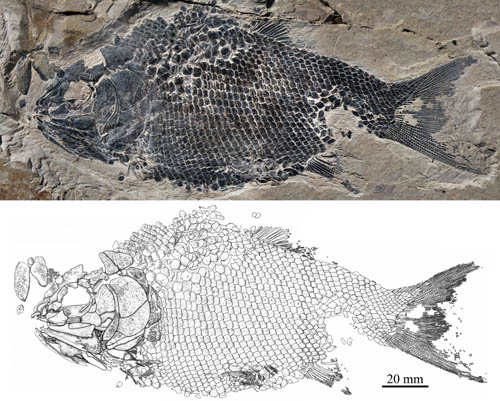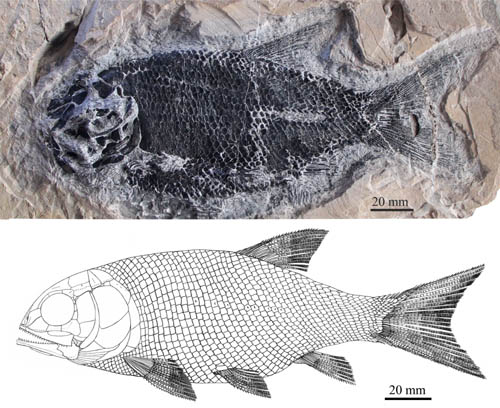| Location: Home > Research > Research Progress |
| New Ionoscopiform Fish Found From the Middle Triassic of Guizhou, China |
|
The Ionoscopiformes are a fossil fish lineage of halecomorphs known only from the Mesozoic marine deposits. Because of their close relationships with the Amiiformes, the Ionoscopiformes are phylogenetically important in investigating the early evolution and biogeography of the Halecomorphi, but fossil evidence of early ionoscopiforms was scarce. Robustichthys recently reported from the Middle Triassic Luoping Biota, eastern Yunnan, China, represents the oldest and only known ionoscopiform in the Triassic. In a paper published in the latest issue of Vertebrata PalAsiatica, Dr. XU Guanghui, Institute of Vertebrate Paleontology and Paleoanthropology (IVPP), Chinese Academy of Sciences, and his colleague reported the discovery of a new ionoscopiform, Panxianichthys imparilis, on the basis of two well preserved specimens from the Middle Triassicof the Guanling Formation exposed in Xinmin of Panxian County, western Guizhou, China. Although Panxianichthys is slightly younger than Robustichthys, it is significantly older than other members of this group from the Late Jurassic of Europe, and Early Cretaceous of North and South America. Panxianichthys possesses an important synapomorphy of the Ionoscopiformes: a sensory canal in the maxilla, but retains some primitive characters unknown in other ionoscopiforms. It is distinguished from other members of this order by a combination of features. Phylogenetic analysis indicates that Panxianichthys is the most primitive ionoscopiform fish, and provides new insight on the early evolution of this clade. The new finding extends the geographical distribution of early ionoscopiforms from eastern Yunnan into western Guizhou, demonstrating a wider distribution than previously appreciated for this group. The successive discoveries of Robustichthys and Panxianichthys from China indicate that the early diversification of the Ionoscopiformes is more rapid than previously thought. This research was mainly supported by the National Natural Science Foundation of China, and the State Key Laboratory of Palaeobiology and Stratigraphy (Nanjing Institute of Geology and Palaeontology, Chinese Academy of Sciences).
|

